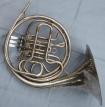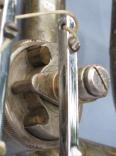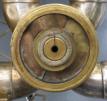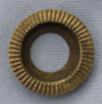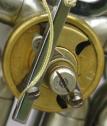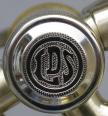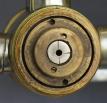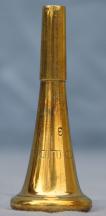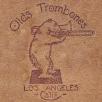
It's a bear!
Pre-WWII Super Olds French Horns
Bore: .468" (11.9 mm)
Bell: 12⅛" (311.15 mm)
If you're spent much time in school band rooms, odds are you've run into an Olds French horn or two. Ambassador single horns (A-45 in F and A-48 in Bb) have helped launch the careers of untold thousands of neophyte hornists. The A-45 and A-48 were introduced sometime around 1950 (this catalog mentions that they are "new"). Olds later added "professional" singles and doubles to their catalog, though the use of those instruments by actual working professionals was quite limited, as they were generally considered "intermediate" or "step-up" instruments.
But the history of Olds horns goes back further than the A-45 and A-48. It isn't widely known, but Olds manufactured a small number of French horns prior to WWII. Both single horns and full double horns were produced.. They used wraps that are unlike those used on the Olds horns produced after WWII; in fact, they are unlike anything I can recall seeing from any other maker. It appears that they were introduced in the late 1930's and discontinued when production was curtailed due to the war. In the partial 1941 Olds catalog on Olds Central, there are listings for French horn cases (in "Special" and "Super" grades) and mouthpieces (three sizes), but the pages listing the horns themselves aren't there. I can confirm that Special single F's were produced; thus far, I have not seen evidence of a Special double. The mouthpiece page of the 1941 catalog mentions that their No. 3 mouthpiece is suited for single Bb horns, so it's possible that Bb singles were produced (or at least planned), but that's slim evidence, and I have never seen an Olds single Bb from this era.
Curiously, the cover of this circa 1950 catalog shows what appears to be a pre-WWII Super double, though the horn is not shown in the catalog. There is a full page dedicated to the Ambassador singles(in Bb or F), and a brief mention of a double being in the works. I suspect the double being referred to is the O-45 design, which was based on the Conn 6D.
So - why did Olds decide to introduce horns? Well, I have a couple theories:
- Olds was insprired by the tremendous success that Conn was having with their Model 8D double horn (introduced in 1937).
- The deterioriating situation in Europe was making German-made horns (which were very popular in American orchestras at the time) difficult to obtain (and, to some players, morally objectionable).
Where the silver plate is worn on the bell, it appears that the underlying material is yellow brass. The "tone control band" is apparently nickel silver, as would be seen on other Super instruments of the era, and is hand-engraved. Also present are the streamlined Super-style braces. The valves are interesting in that they have two sets of redundant bumpers (rather that the normal single set) and an ingenious detented nut and spring system that is looks like it is intended to keep the bearings tight, along with an ornate valve cap. The serial number is in the 1xx range, indicating that Olds used a separate sequence for these instruments. Playing-wise, this particular instrument is problematic; the written F at the top of the staff does not center well.
Super Olds Double Horn in Bb-F
There's a good story that goes with this one. I'd foolishly let a couple similar instruments get away from me a few years back, and hadn't seen any more for sale since. I sent inquiries to some of the dealers who handle a lot of vintage horns, but to no avail. Then, in 2015, the International Horn Symposium was held up in Los Angeles. Since my wife, a horn player, was planning to attend anyway, I loaded her down with a stack of "Wanted" posters to distribute to the vendors. A day or two later, I got an email from Dennis Houghton of Houghton Custom Horns in Houston, Texas. Seems he had a horn I might be interested in...
According to Dennis Houghton, it came from the estate of Dr. John Woldt, longtime horn professor at Texas Christian University. He thinks it might have been sent to Dr. Woldt by Olds sometime in the 1950's. The bell has a fairly large throat, somewhat in the Conn 8D style. It's primarily yellow brass, with nickel silver trim (including the hand-engraved tone ring). The valve layout is in the Geyer/Knopf style, with the change valve adjacent to the third valve. Like the single F horn above, the valves have the redundant bumpers and internal adjustment feature, though they lack the detent system (since this horn has a higher serial number, it's possible Olds decided the detent was unnecessary). It also shares the same ornate valve cap design; I have seen photos of a similar Olds double where each valve cap had a single letter, "O-L-D-S", and of a Studio single F with caps spelling out "F-E-O".
I've included a photo of an Olds horn mouthpiece; it was purchase separately, but (based on the lettering style) it appears to be from the same period as this instrument.
Not being a horn player myself, I can't personally comment on the playability of this instrument, but I am told it's quite good. At the very least, it does not suffer from the "bad note" mentioned for its single F sibling.

